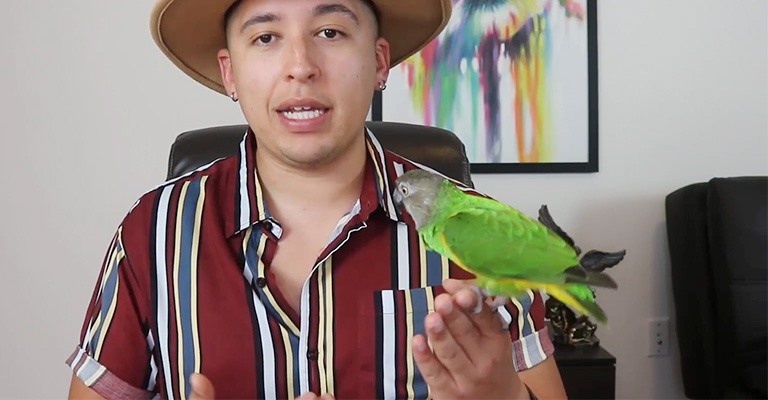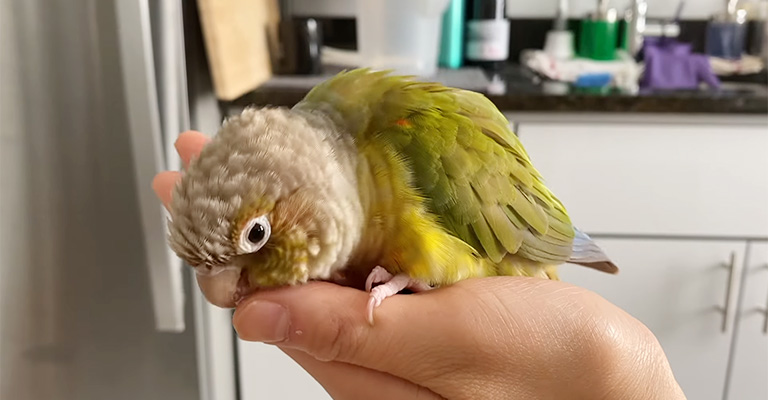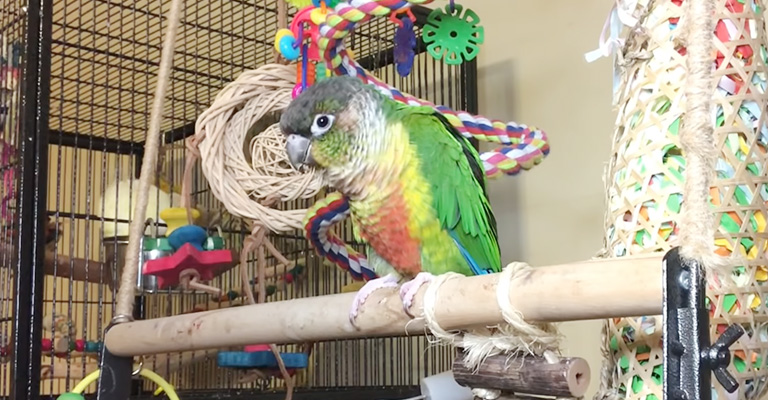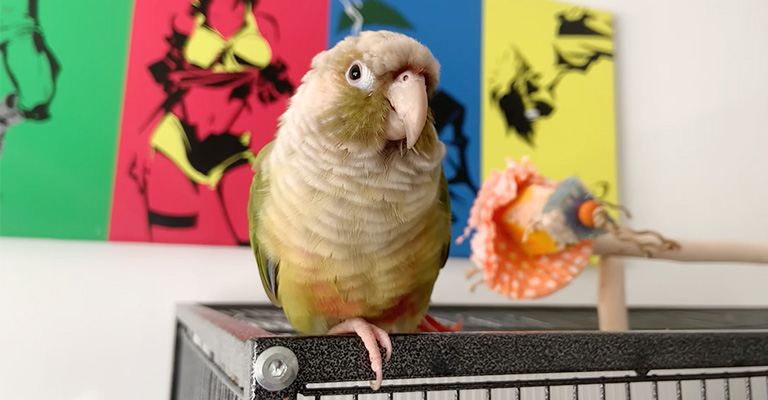Parrots are known for their vibrant plumage, charming personalities, and often, their unpredictable behavior. One perplexing behavior that many parrot owners encounter is lunging. If you’ve ever wondered, “Why does my parrot lunge at me?” you’re not alone.
This behavior can be unsettling and, at times, even dangerous, leaving parrot owners bewildered and concerned about their beloved feathered friends.
In this blog post, we’ll delve into the fascinating world of parrot behavior to shed light on the reasons behind this peculiar conduct.
By gaining a deeper understanding of the causes, you’ll be better equipped to address and manage this behavior, creating a safer and more harmonious environment for both you and your parrot companion. So, stay focused.

Parrot Behavior Basics
Parrot behavior is fascinating and diverse. These birds are known for their intelligence, social nature, and vocal abilities. Parrots are highly social animals, often forming strong bonds with their owners or other parrots. They thrive on interaction and mental stimulation.
One key aspect of parrot behavior is their vocalization. They communicate through a variety of sounds, including squawks, chirps, and mimicry of human speech. Parrots can learn words and phrases, making them excellent talkers.
Chewing and foraging are essential behaviors for parrots. Their strong beaks need regular exercise, so providing toys and safe objects to chew on is crucial. Additionally, hiding food in toys or puzzles encourages their natural foraging instincts.
Parrots also display body language cues like fluffing their feathers, head bobbing, and tail movements to convey their emotions. Understanding these signals is essential for ensuring their well-being.
Reasons Behind Parrot Lunging
Parrot lunging is a behavior where a parrot extends its body toward a person or object aggressively, often accompanied by an open beak and hissing sounds. Several reasons can explain why a parrot may lunge:
Fear or Anxiety
Parrots may lunge when they feel threatened or scared. This is a defensive reaction meant to create distance between themselves and the perceived threat.
Territorial Behavior
Parrots can be territorial, especially around their cages or specific areas. Lunging may occur when someone approaches their perceived territory.
Protecting Their Mate or Nest
Breeding pairs of parrots may become protective of their mate or nest, leading to aggressive behavior, including lunging.
Frustration or Agitation
Parrots have their moods, and if they are frustrated or agitated, they may lunge as a sign of irritation.
Hormonal Changes
During hormonal periods, like the breeding season, parrots can become more irritable and prone to aggressive behaviors, including lunging.
Lack of Socialization or Training
Improper socialization or training can result in behavioral issues, including lunging. Parrots that haven’t been exposed to various people, environments, or experiences may be more prone to fear-based aggression.
Health Issues
Sometimes, underlying health problems can cause discomfort or pain, leading to aggression, including lunging. It’s essential to rule out medical issues in such cases.
To address parrot lunging, it’s crucial to understand the underlying cause. Consultation with a qualified avian veterinarian or a professional parrot behaviorist can help diagnose the issue and develop strategies to manage or modify the behavior safely.
Recognizing Parrot Body Language When It’s Lunging

Recognizing a parrot’s body language when it’s lunging is essential for understanding the bird’s emotions and preventing potential harm. Here are some key body language cues to look for:
Extended Body
When a parrot lunges, it will typically extend its body towards the target of its aggression. The parrot may lean forward or stretch its neck to reach out.
Open Beak
A lunging parrot often opens its beak wide, showing its sharp beak as a threat. This can be accompanied by hissing or growling sounds.
Feather Fluffing
The feathers on a lunging parrot’s body may become fluffed up, making the bird appear larger and more intimidating. This is a defensive posture.
Dilated Pupils
The parrot’s pupils may dilate when it’s agitated or fearful. Dilated pupils indicate heightened arousal.
Tail Position
Pay attention to the position of the parrot’s tail. A raised tail can be a sign of aggression or irritation.
Head Movements
Watch for head movements, such as rapid bobbing or jerking. These movements can signal agitation or readiness to strike.
Vocalizations
Lunging is often accompanied by vocalizations like squawking, screaming, or hissing. These sounds can convey the parrot’s emotional state.
Raised Feathers on the Nape
Some parrots have a patch of raised feathers on the nape of their neck, known as “hackles.” When a parrot is agitated, these hackles may stand up.
Body Stance
Observe the overall body posture of the parrot. A lunging parrot may lower its body and crouch slightly in preparation for a lunge.
Pinning Eyes
Parrots may “pin” or rapidly contract and dilate their pupils when they are feeling intense emotions. Pinning eyes can be a sign of agitation or anger.
It’s crucial to remember that parrot body language can vary between individual birds and species. Understanding your specific parrot’s body language and behavior patterns is key to interpreting their signals accurately.
Tips to Preventing Parrot Lunging

Preventing parrot lunging and aggressive behavior requires patience, consistency, and a good understanding of your parrot’s needs and triggers. Here are some tips to help prevent parrot lunging:
Positive Reinforcement
Use positive reinforcement techniques to reward desired behaviors. When your parrot behaves well, offer treats, praise, or affection. This encourages good behavior and builds trust.
Socialization
Expose your parrot to various people, environments, and experiences from a young age. Proper socialization can help reduce fear-based aggression.
Create a Safe Environment
Ensure your parrot feels safe and secure in its environment. Avoid placing its cage in high-traffic or noisy areas, which can cause stress.
Routine and Predictability
Parrots thrive on routine and predictability. Stick to a consistent daily schedule for feeding, playtime, and interaction.
Respect Their Space
Respect your parrot’s personal space, especially around its cage. Avoid reaching into the cage without invitation, which can trigger defensive behaviors.
Body Language Awareness
Pay close attention to your parrot’s body language. Learn to recognize signs of fear or agitation and adjust your approach accordingly.
Training and Desensitization
Use positive reinforcement training to desensitize your parrot to situations or objects that trigger lunging. Gradually expose them to these triggers in a controlled, positive manner.
Avoid Punishment
Never punish your parrot for lunging or aggressive behavior. This can worsen the problem and damage your relationship with the bird.
Provide Mental Stimulation
Parrots are intelligent and need mental stimulation. Offer toys, puzzles, and foraging opportunities to keep them engaged and reduce boredom-related aggression.
Healthy Diet
Ensure your parrot receives a balanced and nutritious diet. Proper nutrition can have a positive impact on behavior and overall health.
Regular Veterinary Checkups
Schedule regular checkups with an avian veterinarian to rule out any underlying health issues that may be contributing to aggressive behavior.
Consult a Professional
If your parrot’s lunging behavior persists or worsens despite your efforts, seek guidance from a professional avian behaviorist or trainer who can provide specialized advice and training techniques.
Remember that preventing lunging and aggressive behavior in parrots may take time and consistent effort. Building a trusting and positive relationship with your parrot is crucial for long-term success in managing their behavior.
When Should You Get Concerned for Parrot Lunging?

You should become concerned about parrot lunging when it becomes frequent, intense, or is accompanied by other concerning signs. Here are some situations when you should be concerned and consider seeking professional help:
Frequent Lunging
If your parrot is lunging at people or objects on a regular basis, it may indicate an ongoing problem that needs attention.
Intense Aggression
If the lunging is accompanied by aggressive behaviors such as biting, attacking, or persistent screaming, it poses a safety risk to both the parrot and the people around it.
Injury
If the lunging results in injuries to the parrot or others, immediate intervention is necessary. Injuries can range from scratches to serious bites.
Sudden Change in Behavior
If your parrot’s behavior suddenly changes, and it starts lunging when it didn’t before, it could be a sign of an underlying issue, such as illness or stress.
Fear or Stress Signs
Lunging accompanied by other signs of fear or stress, such as panting, fluffed feathers, or cowering, should raise concerns about the bird’s well-being.
Consistent Agitation
If the parrot remains agitated, defensive, or fearful despite efforts to address the issue through training and environmental changes, it’s time to consult a professional.
Endangering Other Pets
If your parrot lunges at other pets in your household, especially if it results in harm to them, this is a serious concern.
Deteriorating Bond
If your bond with your parrot is deteriorating due to lunging or aggressive behavior, it’s important to address the issue promptly to maintain a positive relationship.
In such cases, it is advisable to consult with a professional avian behaviorist, trainer, or an avian veterinarian with expertise in behavior. They can assess the situation, identify the underlying causes of the lunging, and provide guidance on how to address the issue effectively and safely.
Things to Avoid When Your Parrot Is Lunging
When your parrot is lunging or displaying aggressive behavior, it’s crucial to handle the situation carefully to prevent harm and avoid exacerbating the issue. Here are some things to avoid when your parrot is lunging:
Don’t Punish
Avoid punishing your parrot for lunging. Yelling, hitting, or other forms of punishment can increase fear and aggression, making the problem worse.
Don’t Scream or Yell
Shouting at your parrot in response to lunging can escalate the situation. Instead, remain calm and composed.
Don’t Approach Aggressively
Avoid approaching the parrot quickly or forcefully. Sudden movements can trigger defensive responses.
Don’t Corner Your Parrot
Never back your parrot into a corner or force it into situations where it feels trapped. This can intensify fear and aggression.
Don’t Force Interaction
Respect your parrot’s boundaries. If it’s displaying aggressive behavior, don’t force physical contact or interaction.
Don’t Remove Toys or Perches
Removing objects your parrot may be lunging at can increase frustration. Instead, use positive reinforcement and training to redirect their behavior.
Avoid Stressful Environments
Ensure your parrot’s living environment is calm and free from stressors. Loud noises, excessive activity, or other stress-inducing factors can contribute to lunging.
Don’t Provoke or Taunt
Never taunt or provoke your parrot, as this can exacerbate aggression and damage the trust between you and the bird.
Don’t Ignore It
While it’s important not to react with aggression or punishment, ignoring the behavior completely isn’t helpful either. Seek professional advice and actively address the issue.
Don’t Skip Veterinary Care
If the lunging behavior is unusual or sudden, consult an avian veterinarian to rule out underlying health issues. Pain or discomfort can contribute to aggression.
Don’t Give Up
Aggressive behavior in parrots can be challenging to address but don’t give up. Seek guidance from a professional avian behaviorist or trainer to develop a plan for behavior modification.
Remember that parrots exhibit lunging behavior for various reasons, including fear, territoriality, or stress.
FAQs
Parrots may lunge when you approach their cage due to territorial instincts. They see their cage as their territory and may feel the need to defend it. It’s essential to respect their space and approach calmly to reduce this behavior.
Sudden lunging can result from changes in your parrot’s environment, health issues, or fear due to a recent traumatic event. It’s crucial to investigate potential triggers and consult with a professional to address the underlying cause.
To prevent lunging during playtime, ensure your parrot is comfortable and relaxed. Gradually introduce new toys and experiences, use positive reinforcement for good behavior, and be patient. Avoid pushing your parrot beyond its comfort zone to build trust and reduce aggression.
Yes, hormonal changes, especially during the breeding season, can lead to increased aggression and territorial behavior in parrots. Extra care, consistent training, and minimizing hormonal triggers like nesting materials can help manage this behavior.
If your parrot lunges and bites, avoid reacting aggressively. Stay calm, gently remove yourself from the situation, and give your parrot a “time-out” in its cage. Consult with an avian behaviorist to address the underlying causes of biting and develop a plan for behavior modification.
Wrapping Up
In the world of avian companionship, comprehending parrot behavior is the key to fostering a strong and affectionate bond with your feathered friend. While parrot lunging may seem bewildering, it’s often a response to specific triggers or needs.
By patiently addressing these underlying causes, seeking professional guidance when necessary, and practicing positive reinforcement, you can work towards reducing or preventing this behavior.
Remember, every parrot is unique, and it may take time and effort to create a peaceful and loving relationship. With dedication and understanding, you can help your parrot thrive in a safe and happy home. Best of luck.